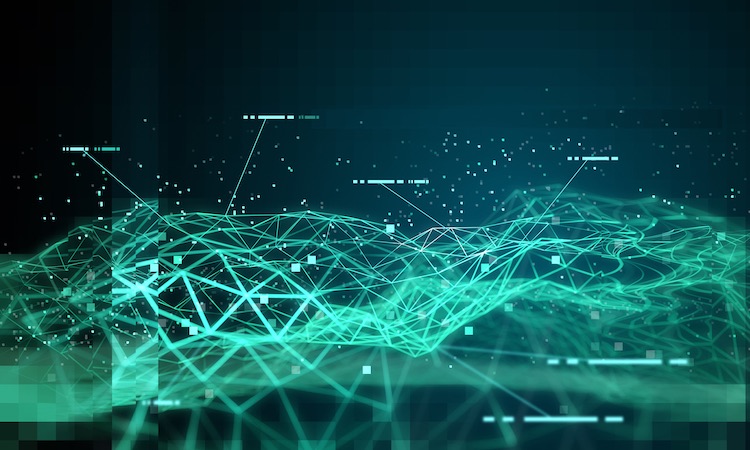
Data is fast defining the geostrategic power of nation states and the nature of their societies, writes Nicholas Dynon. According to speakers at the NZDIA IDEAS 2020 event, this presents big challenges for New Zealand.
This article is part of our focus on the New Zealand Information Domain. View more articles here.
Humankind is moving in faster and in ever more connected ways towards a future in which data – the building blocks of information – will be the single most important measure of a nation’s geostrategic power. It’s a process that’s already begun.
In the information age, the ability to harness data instantly and to protect it from a proliferating array of information weapons is becoming paramount. It’s within this context that the New Zealand Defence Force (NZDF) and Ministry of Defence have turned their focus to the Information Domain.
In the New Zealand Defence Industry Association’s (NZDIA) IDEAS 2020 Part One virtual event, Defence called on Industry to help it define the New Zealand Information Domain and to identify the new models of organisation, engagement and working necessary to face the challenges of the information age.
According to expert insights articulated several weeks later at IDEAS 2020 Part Two, New Zealand has significant ground to make up and some tough choices to make – and these go well beyond the remit of Defence.
The big picture: Speed and connectivity
According to Callaghan Innovation’s Vic Crone, by 2040, Artificial Intelligence (AI) will be everywhere. 50 percent of all cars will be autonomous, augmented reality and virtual reality will be the viewing platform of choice, and we will transition to that through voice control, touch control, and, potentially, through developments in mind control.
Half of all jobs would have been automated by then, which is just as well given that the working age population will have increased by only 10 percent. Robotics automation and machine learning will need to fill the jobs vacated by those entering retirement. 50 percent of the workforce will be Maori, Pacifica and Asian.
According to Vodafone’s Matt Hitti, with 5G “everything that could be connected or can be connected, will be connected.” Fast internet and low latency will make possible remote surgeries and activities that rely on “being able to really feel how something is moving remotely and have it moved an exact lock step.”
Myriad material objects, such as Internet of Things (IoT) devices, will have sensors placed in them that will be able in real time to monitor and potentially control them and make better decisions as a result. Massive amounts of data will therefore be collected for analysis in real time.
The data we’ll be collecting, says Teradata’s Stephen Brobst, won’t just be growing in size, but also in diversity, including all kinds of geospatial data and non-traditional semi-structured data. We’ll need “different kinds of processing capability beyond the square tables and columns type of model for being able to do advanced analytics.”
And, clearly, the speed and connectivity that allow us to do the above will necessitate faster and more connected cybersecurity controls. “We ought to be optimising around the fundamental forces of the cyber domain,” stated Fortinet’s Philip Quade, “which are speed and connectivity, else we’re just fighting gravity.”

The strategic context: Data as power
Traditionally, measurements of a nation’s geostrategic power were based on formulas involving territory, natural resources, populations, the strength of conventional military forces, and the political systems to effectively coordinate these. The information age and its fourth industrial revolution have relegated such calculations to history.
In upcoming years and decades, it will be data that determines the superpower
“In upcoming years and decades, it will be data that determines the superpower,” says Sadegh Riazi, founder and CEO of CipherMode Labs. “The quality of the data, as well as the ability to process large volume of data will be the differentiating factors.” This echoes the sentiments of top Indian officials who have called data a new form of national wealth.
James Williams from the University of Canterbury notes that states like the USA, Russia and China are increasingly sparring within the information domain, or data domain. He attributes this to the rapidly falling cost of data collection and the growing ubiquity of sensors in terms of the IoT and distributed devices.
“We have data that shows very clearly, tracking democratic election cycles in several countries the last couple years,” explains Microsoft’s Mark McIntyre, “and it’s just like clockwork, where we see mostly Russian activity against Western democracies leading up to their local national election cycles.”
“Part of the development we’re seeing around this is that algorithms are being designed that can operate on a wider range of data sources, and can predict increasingly complex outcomes easily, he explains. “We’ve gone from just simple, straightforward prediction and classification, and we’re looking at these subtle manipulations of social networks for either economic, social, or political gain.”
According to Williams, and many of his fellow speakers, it’s not having the best algorithms that matters – it is having the best data.
Lockheed Martin’s David Fallon discusses this in the context of multi-domain operations and the ‘grey zone’, or the fuzzy space between interstate competition and conflict. “How do you prepare and work in those spaces where the use of social media may be an actual start point to any sort of conflict?” he asks.
Mark McIntyre from Microsoft notes that the asymmetric nature of data-enabled interstate competition means that it becomes a potential battlespace for weaker states looking to project regional power. “It’s cheap, much cheaper than having to afford the upkeep of a military,” he explained. “You can hide, it’s really hard to do attribution in the security landscape.”
Attribution difficulties may mean that adversaries can hide in cyberspace, but in data rich physical battlespaces, hiding will become increasingly difficult. Fallon suggests that the next fight will be a battle of signatures. “Everything we see and do can and will be observed.”
The strategic importance of data is reflected, notes McIntyre, by the fact that the US Defense Department has just-published its first ever data strategy. NATO has now also officially designated cyber as a new domain, and these developments will lead to “more and more of a convergence around data-enabled, multi-domain realities in warfare.”
In New Zealand, the focus on data is reflected in the Defence Technology Agency’s four-year plan. The DTA’s Rob Read explains that the technology focus areas for the NZDF ‘s tech research arm are Automation, AI, data analytics and exploitation, multi-domain awareness, and manned and autonomous systems.
Challenges for New Zealand
Investment
The big challenge with New Zealand, says Vic Crone, is that our research and development is very low compared to other OECD countries.
“We sit at around 1.4 percent in terms of R&D. The OECD average is over two percent, and the problem with that is that we are not applying the new technology coming through – including AI, robotics, AR, VR, drones, 3D printing, 4D printing. We’re not taking that and applying it and researching and understanding how it can evolve our products and our services.”
The big problem with this, she explains, is that these technologies are cumulative – they build on each other – starting with the internet, mobility and social media and cloud.
“We’re now hitting the era of building on top of that – big data, machine learning, internet of things, robotics, cybersecurity. Then what’s going to build on top of that again is AR, VR, biometric identity, deep learning, large scale machine learning, natural language processing, blockchain, 3D printing, and 4D printing.
“And then what’s building on that technology is all the autonomous systems for cars and drones and vehicles, nanotechnologies, advanced robotics into cyborgs and swarm bots, supercomputing. And then we go into autonomous super systems.”
The message is glaringly simple: if you aren’t able to transition your organisation or your industry into the basics of machine learning, big data, AI, then you’re not going to make it to the next level.
In an era in which the ability to wrangle data will determine the balance of international power, New Zealand is at risk of being left behind.
This is already evident in our widely acknowledged undersupply of people skilled in data and the protection of data, and it’s a challenge that is beyond the Ministry of Defence and the NZDF. It requires all-of-government and all-of-society solutions.
Trust
With a ranking of 1 out of 198 countries in Transparency International’s Corruption Perceptions Index, an area in which New Zealand does punch above its weight is political transparency and trust in government. “We are seen externally and internally to be a high-trust society and a country which is transparent and has high-trust political systems,” notes Auckland University’s Kate Hannah.
Kate Hannah and her team from University of Auckland have studied the role of social networks in New Zealand’s COVID-19 disinformation landscape, identifying connections between COVID-19 disinformation and more extreme positions, such as white supremacism, extreme misogyny, and Q-Anon. The malevolent exploitation of extreme narratives online poses major potential national security challenges.
But, just as targeted online activity can exploit and cultivate distrust in government, so too can data breaches due to inadequate information security, as well as poorly developed and poorly explained analytics.
During 2019 alone, simple security mistakes within New Zealand Government agencies led to serious data loss events, including the high-profile NZ Police gun buy-back scheme and Tu Ora Compass Health breaches – the latter resulting in the potential exposure of sensitive medical information belonging to one million people. Many of these could have been avoided with better oversight, governance, policies and procedures.
According to Microsoft’s Russell Craig, the development of AI has resulted in a new category of risk of harm “where automated decision-making systems, if they’re not well-governed, if they’re not being developed using proper ethical principles, could lead to actual harm.”
He points to the fact that facial recognition algorithms have been found to be biased, particularly in favour of white males, and that healthcare remains an area of risk. “If models aren’t appropriately trained by people that understand bias at quite a deep level and domain specific level,” he explains, “diagnosis could be supported by automated decision-making systems that could be quite wrong.”
Immigration New Zealand’s pilot data modelling programme was pulled in April 2018 amid allegations that it involved racial profiling, that it utilised a predictive algorithm leading to prejudicial enforcement action, and that it breached privacy in terms of the use of individuals’ personal data.
Importantly, issues of trust are tied to issues of data ownership and the control and individuals and organisations have over their data.
According to Atawhai Tibble from the Social Wellbeing Agency, the characteristics of data as powerful yet vulnerable fit with a Māori view of taonga. Data is precious, and it requires protection. Māori perspectives on data and data sovereignty, therefore, must inform New Zealand’s approach to managing this strategic resource.
It’s an area in which partially developed technologies and an absence of robust legislative safeguards around its use leaves the window wide open for potential abuse and exploitation. Like the aforementioned challenge of investment, the challenge posed by trust requires all-of-government and all-of-society solutions.
What does it all mean?
As a national resource – as a critical source of national geostrategic power – data will shape the international order and New Zealand’s place within it. And in an era of constant competition, we won’t need to wait for a kinetic conflict to witness this. It’s happening right now.
Accordingly, and as the speakers of IDEAS2020 Part Two have highlighted, the development of a New Zealand Information Domain will need to reflect the inherent pervasiveness of data, and an understanding of information as a battlespace in which militaries are just one of a spectrum of actors.
An information domain focused on the strictly military capabilities – electronic warfare, intelligence, cyber security, C4 and the Defence Information Environment – will be of little use to the security of New Zealand if, devoid of the faintest hint of armed conflict, our critical national infrastructure is crippled by cyberattack, or trust in our democratic institutions is destroyed by disinformation.
In the ‘smokeless battlefield’ of the information age, success or defeat will almost certainly precede armed conflict as opposed to coming as a result of it.
IDEAS (Information Domain Engagement and Acceleration Summit) 2020 Part Two was hosted by the New Zealand Defence Industry Association virtually on 4-5 November.
If you have a news story or would like to pitch an article, get in touch at editor@defsec.net.nz.
Sign up to DEFSEC e-Newsletters.






